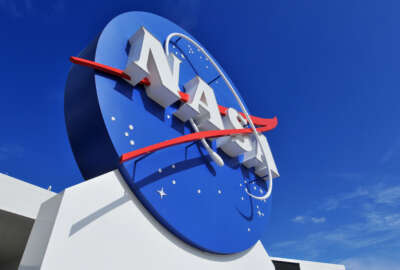Newest constellation of weather satellites gets flight plan
Space Hour host Eric White spoke to Dylan Powell, Lead Strategist for Weather and Earth Science at Lockheed Martin.
Today we’re talking about the weather. Well not the actual weather itself, but the hardware needed to track it. Recently, NASA selected Lockheed Martin to build the nation’s next generation weather satellite constellation, Geostationary Extended Observations, or GeoXO. It’s a contract with an estimated value of just over $2.25 billion. To find out what the GeoXO mission is all about, the Space Hour host Eric White spoke to Dylan Powell, Lead Strategist for Weather and Earth Science at Lockheed Martin.
Interview Transcript:
Eric White All right, and is that a weather side that we’re going to be mostly focusing on here, as we’ll be talking about the geostationary extended observations program that you all are running for NOAA? Why don’t you Why don’t we just start from there, if you can kind of give me an overview of what this this new project? Well, I guess it’s almost a continuation isn’t it?
Dylan Powell It’s, it’s actually a follow on to the GOES-R series of geostationary weather satellites for NOAA. We are the incumbents for the spacecraft and two of the instruments on GOES-R. And what NOAA does is they will procure through their partners at NASA block buys of geostationary satellites. So, you have these series, and they’re generally four blocks. And so GOES-R was for spacecraft for satellites. And we just launched the last of that series GOES-U at the end of last month. And now GeoXO or the geostationary extended observations is the follow on to that GOES-R series. So, it is another block by this time for six with an option for a seven satellite and is the next generation of geostationary weather sentinels for NOAA.
Eric White And where do these spacecraft factor into what NOAA does, what is the agency’s plans for utilizing them?
Dylan Powell So, NOAA uses basically two orbits, for monitoring the Earth’s weather and collecting data that is that is incorporated into the numerical weather prediction models that lead to the forecasts that we all use. And then also for alerts and warnings for severe weather, or wildfires, or that sort of thing. So, the two orbits are a polar orbit and a geostationary orbit. And what the polar orbit is, is a low Earth orbit. The satellites are flying at about, you know, 800 kilometers altitude, and they are circling the Earth and taking global data. And so, they’re, and we call them polar because they have an orbit that flies near the poles and allows the earth to precess underneath them. And so, they can collect this global data. And then with the geostationary weather satellites, those are 22,000 miles above the Earth at the equator and a position that allows them to rotate with the earth. So that NOAA and NOAA’s users can monitor the, you know, at a very high temporal refresh. So, scanning the entire Western Hemisphere every 10 minutes, collecting weather data at a very high rate, but you don’t get the global data from geostationary, but you do get that high temporal resolution, so that you can watch the clouds move, as the geostationary satellite rotates with the earth. So, between these two different constellation of satellites NOAA is able to use that data to feed their numerical weather prediction models and create those alerts and warnings that protect life and property.
Eric White So as far as weather satellites go, you know, with a lot of the subject matters that we discussed on this show. Weather I’ll be honest, you know, weather is, is one that for some reason doesn’t get a lot of focus in the space arena, I guess because you know, it’s kind of seen relied upon as it’s always going to be there as far as weather satellites go. Is this the edge of technology of you know, is this the cutting-edge technology for providing updated weather patterns that no one needs to do its job?
Dylan Powell That’s right, yes, with every series of geostationary weather satellite and every series of their polar weather satellites, NOAA upgrades and capability it takes advantage of technologies that have been developed, you know, since the last series in order to provide users with the data that that they need, as we move into you know, move forward and improve upon our numerical weather prediction improve upon our understanding of, of severe weather, and with geostationary extended observations GeoXO, NOAA is adding a lot of capability to the constellation and they’ve, you know, really come to an architecture that was based on years of engaging their stakeholders, their, their critical users, the National Weather Service other agencies, DoD users across the weather enterprise to understand what they will need going into the 2050s. Because this is a constellation that’s going to provide data for the next 20 years. You know, and, and so we need to understand what those users need and project what they need. And so, what that’s resulted in is a constellation now that will fly three operational satellites, GOES since the early 1970s, the geostationary weather satellites has been flying two operational satellites. One on the East Coast, one on the West Coast monitoring the entire continental US along with Alaska, Hawaii, the Pacific Basin, the Atlantic basin, we’re all of our storms, severe weather and hurricanes are formed. And so now with GeoXO, they’re adding a third operational satellites centrally located over the continental US. And so that satellite is going to fly new instruments that have never been flown in geostationary weather orbit. There, the hyperspectral Infrared Sounder. This is an instrument that will collect vertical temperature and moisture, profiles and information. And of course, moisture and heat are what drives the atmospheric dynamics and our severe weather. So that will scan the entire continental US every 60 minutes and bring that data at that high temporal refresh. And that’s huge. That’s a game changer for the National Weather Service. And for the public in some of that hyper temporal forecasting, really understanding how these storms are developing. Alongside that they’re going to fly an air quality instrument that’s going to also scan the entire continental US. And that instrument is going to collect data on air pollution, different pollutants, you know, within the troposphere, within the area that we’re all breathing. And of course, air quality is, you know, one of the most dangerous killers right now. Every year about 100,000 people die due to air quality issues, which is more than weather. And so, this is an instrument that’s really going to be huge for, you know, EPA, and just for the general public to understand, you know, where dust and where aerosols and where wildfire smoke is headed. And so, it’s going to be able to monitor all of that. And then on the east and west constellation of satellites, their increasing capability for the prime instrument, there is the weather imager. On today’s GOES-R series, that’s the advanced baseline imager, Avi, on the next series, it’s the geostationary extended orbits, extended observations imager, GXI And that instrument collects data in a number of spectral bands that allows NOAA to look at surface temperatures, wildfires, clouds and cloud movement, cloud temperatures, and really images the entire Western Hemisphere every 10 minutes, along with interleaving images of the continental US every five minutes, and then has a special mode where it can scan mesoscale size storms, these 1000 kilometer by 1000 Kilometer storms every 30 seconds. And so, this is an instrument that really is critical to these alerts and warnings. And then alongside that instrument, they’re going to continue the observations of lightning with the LMX, the lightning mapper for geo XO. So that will take pictures of the Earth Western Hemisphere 1000 times per second to capture lightning flashes and that’s been just a you know a real game changer on the GOES-R series which was the first series to fly lightning mapper, allowing us to really look at in intensive convection and understand really severe weather as it’s developing and also protect the public from lightning. And then finally, the other instrument that will be flown is an ocean color instrument. And this is new and never been flown by NOAA before. And so, this ocean color instrument will monitor all of our continental coastlines. It will monitor those ecosystems allow us to understand better the health of those coastal ecosystems which are critical to our food, to recreation, along with allowing NOAA to identify things like harmful algal blooms, which, you know, shut down beaches, because they’re they are poisonous. And so, this will, this will be a huge tool for the National Ocean service, the fisheries and the public for, you know, understanding the health of our coast coastal zones.
Eric White We’re speaking with Dylan Powell and in case you couldn’t tell from that last answer. He is the lead strategist for weather and Earth Science at Lockheed Martin. My word, my friend, that has a lot of new technology that you are all involved with.
Dylan Powell I’m sorry, I’m sorry. I threw it all at you at once. It’s exciting.
Eric White No worries, no worries, no. Impressive. Yeah, you, you had all that off the cuff there. You know, as far as you know, those new technologies go, these satellites are planned to be up there for 50 years, I imagine that there is going to be a mechanism in place where you will be able to add on new ideas and new tech that could also fulfill other needs that NOAA has. Is that the case? And if so, I’d like to follow on with what do you think those needs could possibly be in the future? I’m going to pick your brain a little bit on that front.
Dylan Powell Great, great question. Great question. Yeah. So just want to make clear, the satellites are designed to operate for 15 years, 10 years of operations, and five years of on orbit storage. So, we always maintain on orbit, backups, in case something happens to one of these satellites, we can move an orbit backup over into that position, so we never have gaps. So that’s so just to be clear, it is they are designed to survive for 15 years. But to your question, I think we’ve got a great example with the GOES-R series. So, the GOES-R series flew a number of different instruments, R, S, T and U were primarily copies of each other. There were some changes to fix some issues with the imager from S to T, but for the most part, you know, copies, but with GOES-U, NOAA introduced a new space weather instrument, the compact chronograph C core, on to that platform. And so, Lockheed Martin as the spacecraft provider for that series, we had to integrate this new instrument into the satellite that what originally was never planned to host that instrument. And so, we were able to do that. And with the launch of GOES-U we’ll have those observations of the sun that are going to be so critical for identifying coronal mass ejections and space weather. But with GeoXO, NOAA actually has resources available on that central, that new central spacecraft that’s going to fly the sounder and the atmospheric composition instrument. So, there is there is space, there’s power. There’s resources available for introducing an instrument onto that satellite, with the other two, you know, the east and west satellites. Those are, are really full filled up right now with three different instruments onboard. But, you know, you never know as you go forward, like with GOES-U it was never planned to have a compact chronograph. And we were able to add that late in the program with the last satellite. So, you know, what might we fly? I would, you know, that, that’s, I’ll just go off the cuff here. I mean, I think that, you know, a carbon instrument would be very important. You know, as we know, with climate change and increased, you know, the impact on severe weather, that’s and rapidly changing weather around the globe. You know, having geostationary observations of methane and carbon dioxide, those would really complement the air quality instrument that’s flying there on the central location. Of course, this is all decisions that NOAA would need to make, but they’ve, they’ve created that space on that centrally located satellite for other agencies and even or partners that may have an instrument they want to fly. But just Dylan’s view, I think it would be fantastic to have a geostationary carbon instrument, I think that would be a good complement to, to the whole series of satellites.
Eric White Gotcha. All right. And final word here, you know, it’s like kind of kind of like predicting the weather, it seems on that front, you know, how, how intrinsic are these new ideas and technologies going to be going forward for weather monitoring as a whole. You know, I know that you know, predicting the weather is predicting the weather, but is it just more or is NOAA seemed to be more focused on just data gathering so that they can make better predictions is that the idea behind projects like this one.
Dylan Powell You know, it’s, I think, the way to think about this is, you know, we are living in a rapidly changing environment. And so, a lot of our models and the physics in those models are based on what we understood the climate to be. And because it is changing so rapidly, now, we need these types of observations to understand how it is changing, and how that’s impacting our predictions. Because, you know, you know, a lot of what we do, is even getting down into, you know, building new buildings, and where we’re going to build is based on a climate that really is, is rapidly changing and doesn’t exist, like it used to. And so, you know, having these real time observations and having a diversity of observations, not just the atmosphere, not just the surface in the ocean, but this diversity of, of, you know, all the different earth systems is really going to help us to better understand, you know, what is changing? How do we incorporate those changes into our models, so that we can predict better and improve our predictions as, as the Earth is changing, right, you know, underneath us. And so that’s going to be really important going forward. And I think that’s the way to think about these observations, it’s, you know, one of the great things about introducing new capability into these weathers satellite systems is that you never really know the types of information that we’re going to get from them, we kind of go in now and okay, here’s what we’re shooting for. So, here’s the requirements for this instrument, but then, you know, it gets up there, and the user starts to look at the data, and they find new products and new information that they can derive from this data that we didn’t anticipate. And, you know, so that’s, that’s always the case with every new instrument that we that we fly. And so, there’s, there’s going to be stuff that I can’t think of that, you know, none of us can think of right now that NOAA scientists and NOAA’s users are going to really benefit from. But, you know, I think the bottom line is that, you know, we are we are in challenging times, with climate change and severe weather. I mean, we just saw, the largest hurricane ever recorded. This early in the season, Hurricane Beryl is as we speak, pummeling Texas and so, you know, this is this is real life, you know, impact this is property and lives that are impacted every day, by this, you know, the, the, the changing climate, and that’s the impact on severe weather. So, these, these observations are so critical to help us protect, you know, that life and property going forward. So, they’re needed. It’s, it’s, you know, it’s a real challenge right now.
Copyright © 2025 Federal News Network. All rights reserved. This website is not intended for users located within the European Economic Area.
Eric White is news anchor and Federal Drive producer at Federal News Network.
Follow @FEDERALNEWSCAST






